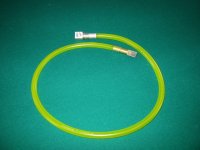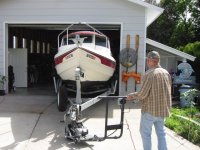Well, I finally figured out how to get all the fuel out of the new Moeller marine tanks. I ordered new flexible 36 inch fuel pickup tubes that enter the vent area and use gravity to slide down into the lowest area of the tanks. Then the original pop-lock fuel pickup tubes are popped out, and the hose removed, and new fittings refitted to use as the vent hookup. Now I can use all the fuel in the tanks instead of leaving about 3-4 gallons.
I now am planning to raise and level the cockpit floor by bulkheading in front of the fuel tanks and pouring an expansive foam into the area. It will seek a level, which I will tilt back slightly to the tanks from the doorway. I would make floor inserts, but the door comes too close to the floor on my 88 cruiser to effectively block them in place -- also on my old 90 cruiser, the floors creaked a bit from the imperfect fit to the floor. The foam I figure on using is 4 #/cf foam supplied by US composites. http://www.uscomposites.com/foam.html . After the foam is inplace, I plan on glassing the foam over with standard layup resin to finish the floor. Have been planning on about 3 layers of 7 1/2 or 10 oz fiberglass cloth. Does anyone see any problems with the plan? Thanks for your input.
I now am planning to raise and level the cockpit floor by bulkheading in front of the fuel tanks and pouring an expansive foam into the area. It will seek a level, which I will tilt back slightly to the tanks from the doorway. I would make floor inserts, but the door comes too close to the floor on my 88 cruiser to effectively block them in place -- also on my old 90 cruiser, the floors creaked a bit from the imperfect fit to the floor. The foam I figure on using is 4 #/cf foam supplied by US composites. http://www.uscomposites.com/foam.html . After the foam is inplace, I plan on glassing the foam over with standard layup resin to finish the floor. Have been planning on about 3 layers of 7 1/2 or 10 oz fiberglass cloth. Does anyone see any problems with the plan? Thanks for your input.



